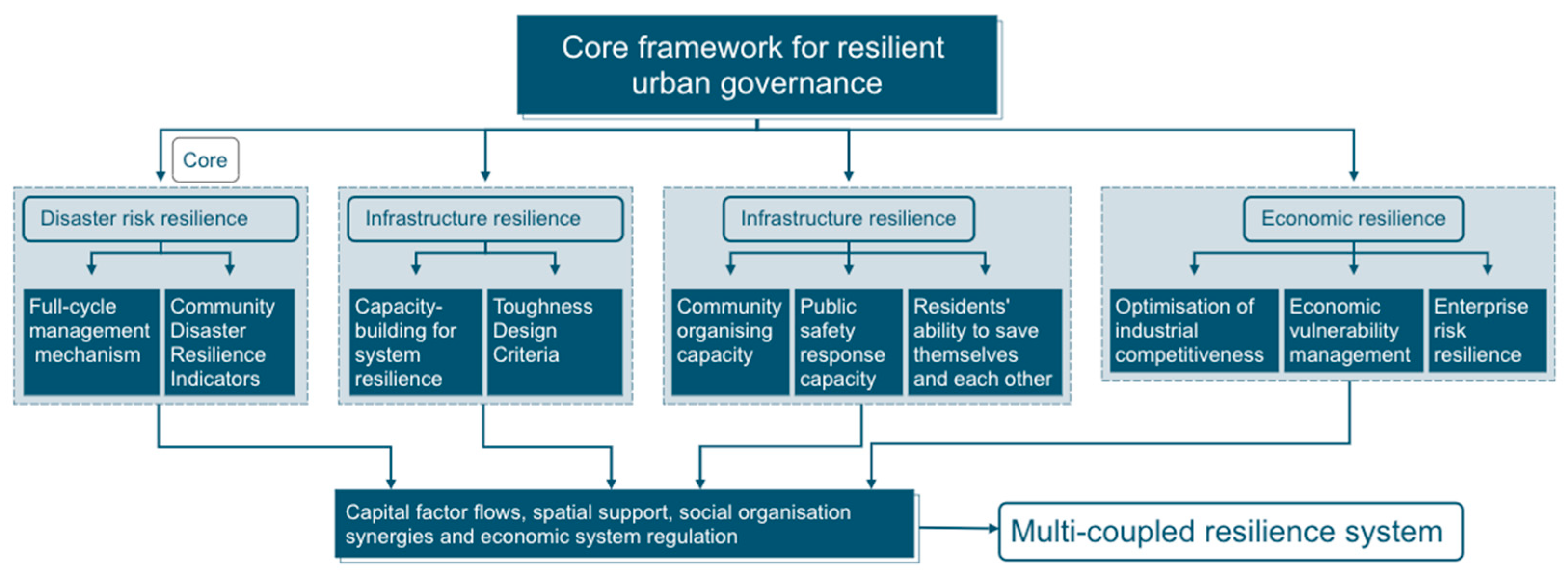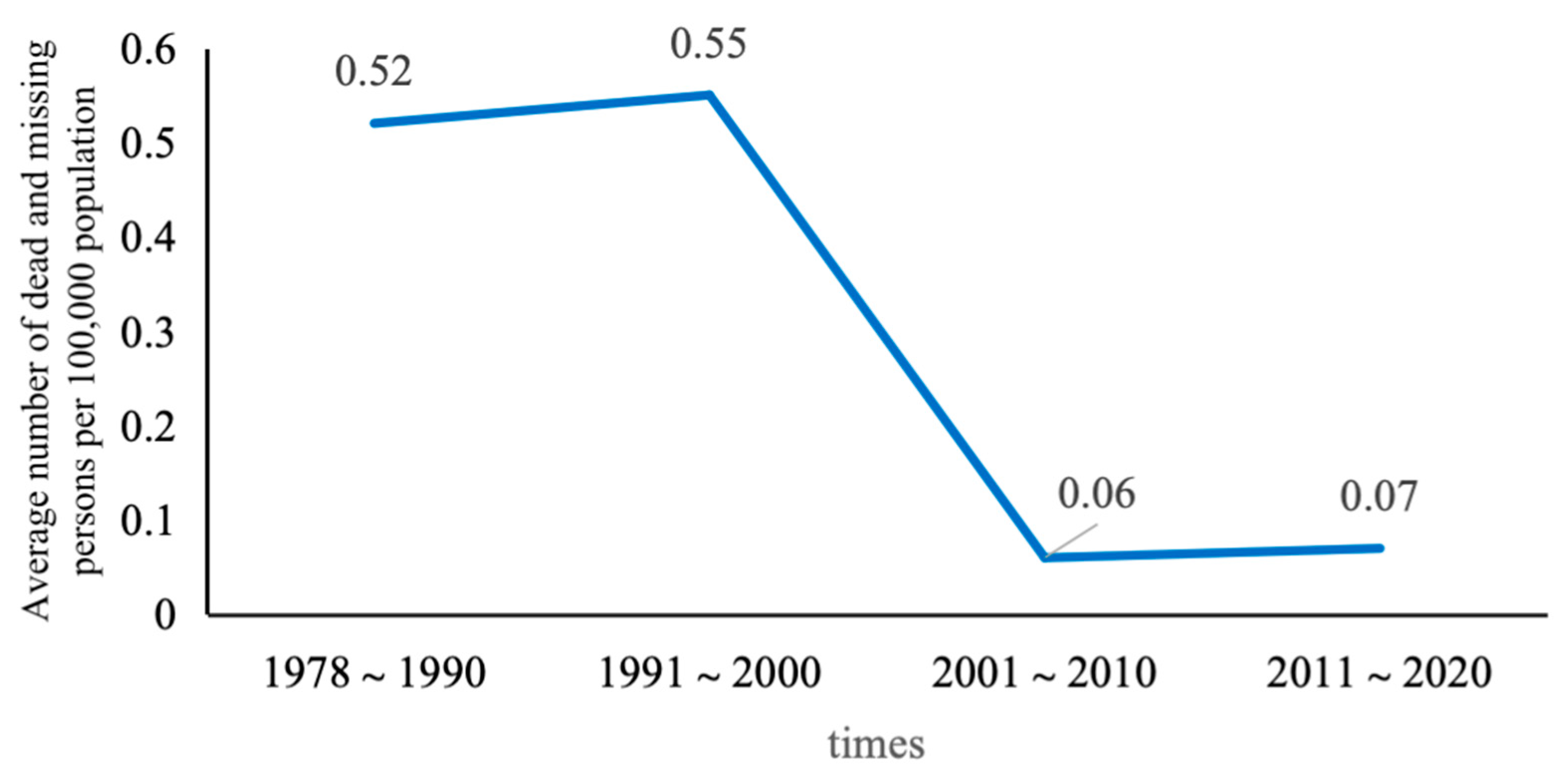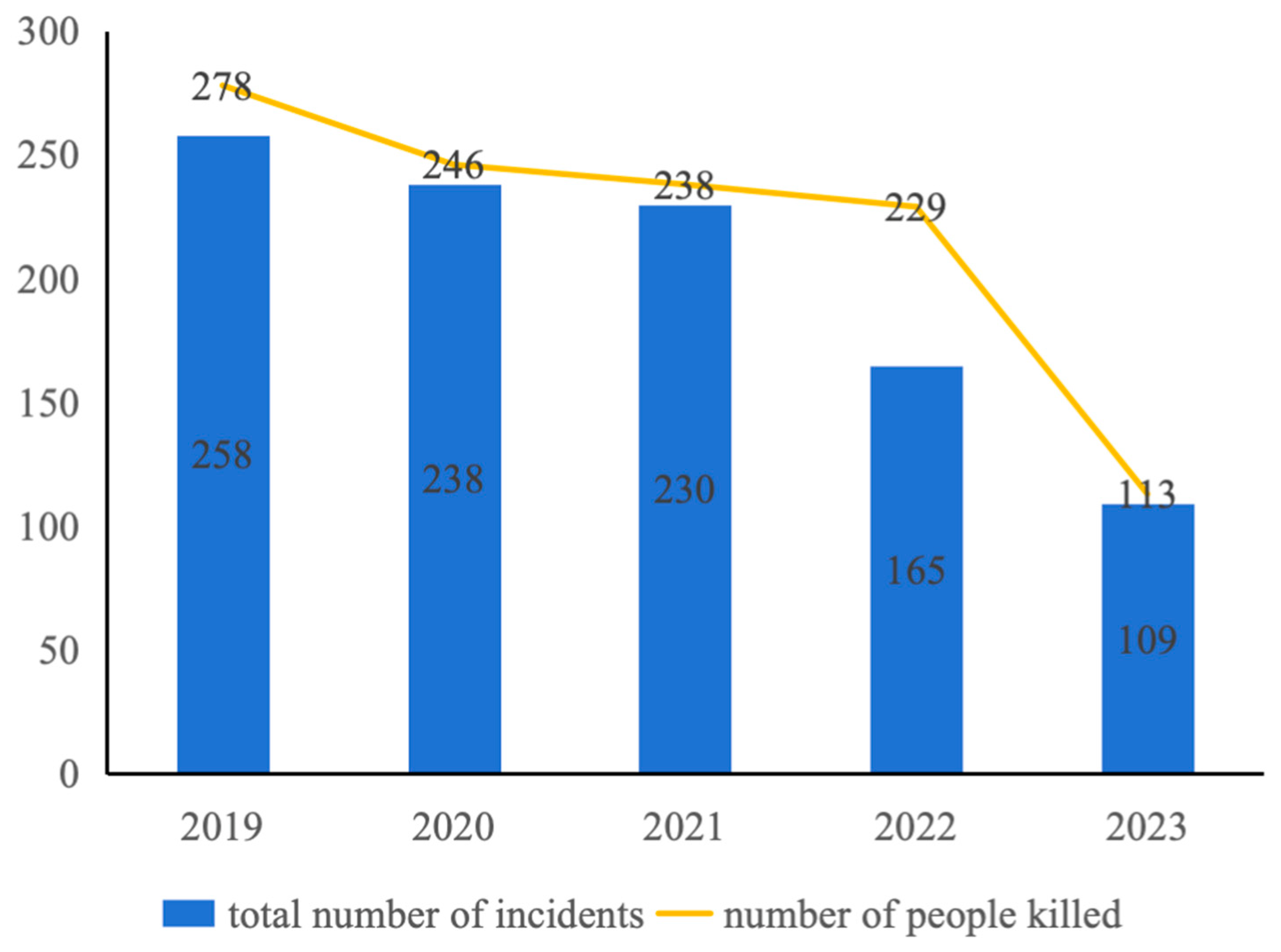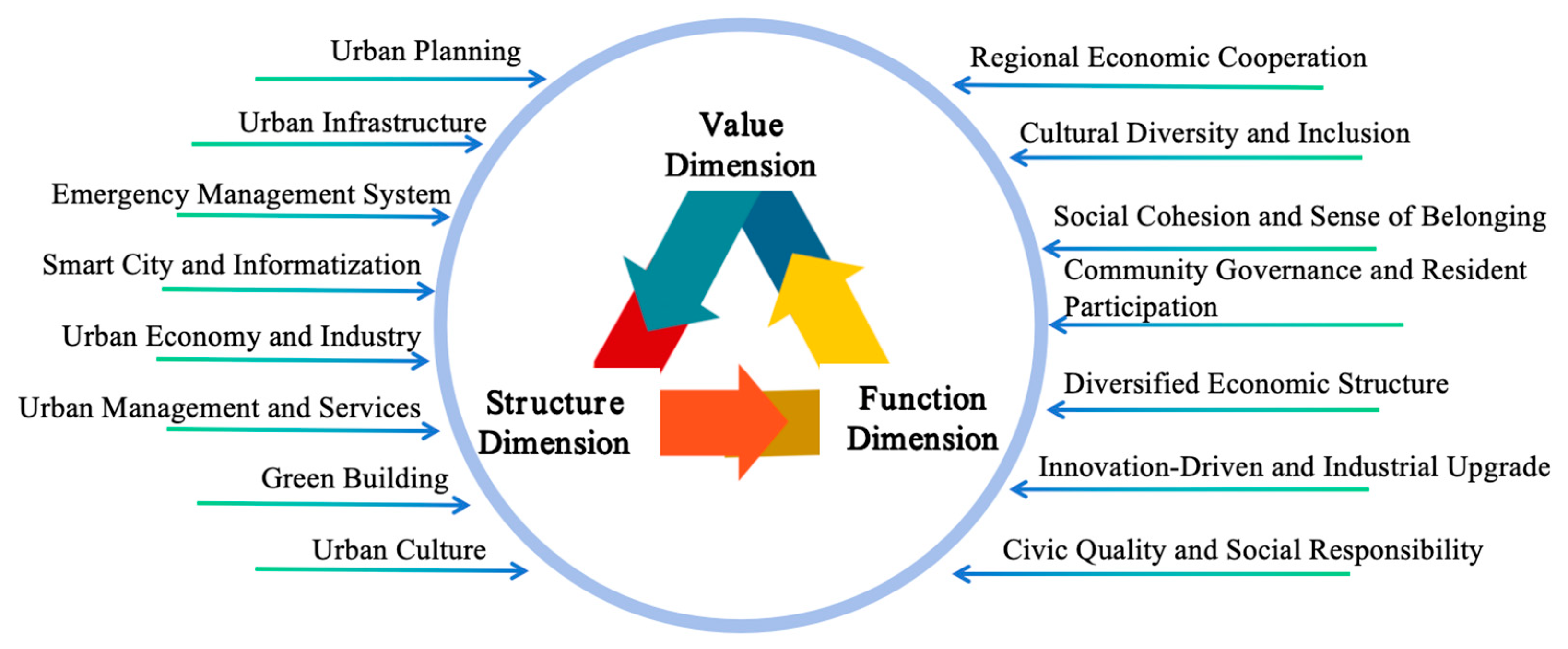Status and Trends of the Application of Resilient Urban Governance Considering the Current State of Resilient City Government in Changsha as an Example
Abstract
1. Introduction
2. Theoretical Framework for Resilient Urban Governance
2.1. Urban Resilience
2.2. Resilient Urban Governance
2.3. Theoretical Framework
3. The Current Situation of Domestic and International Application of Resilient Urban Governance
3.1. Status of Foreign Application
3.2. Current Status of Domestic Applications
3.2.1. National Policy and Strategic Planning
3.2.2. Research Application
4. Discussion on the Path of Creating a Resilient City in Changsha
4.1. Analytical Methods
4.1.1. The Analytical Methods
4.1.2. Data Source
The Government Cloud Platform and Smart City System
The Normalized Hidden Danger Investigation Mechanism
IoT Perception Network
Departmental Special Databases
Anonymous Questionnaire
4.1.3. Datatypes
4.2. Analysis of the Main Risks Facing the City of Changsha
4.2.1. Natural Disasters
4.2.2. Infrastructure Risks
4.2.3. Social Risks
4.3. Exploring the Path of Resilient City Governance in Changsha
4.3.1. Resilient Governance of Disaster Risks
4.3.2. Infrastructure Resilience Governance
4.3.3. Social Resilience Governance
4.3.4. The ‘Three-Dimensional and Fifteen-Wing’ Resilience Governance System
4.3.5. Comparison with the Governance Models of Major Cities Around the World
5. The Development Trend of Resilient City Government
5.1. Data-Driven and Intelligent Governance
5.2. Sustainable Development and Environmental Protection
5.3. Policy Support and Financial Input
6. Conclusions
Author Contributions
Funding
Data Availability Statement
Conflicts of Interest
References
- Zhang, H.; Liu, Q.; Li, G. Rigidity Elasticity Resilience—Spatial Planning Evolution and Reflections on Innovative Industries in Shenzhen. Int. Urban Plan. 2017, 32, 130–136. [Google Scholar]
- Zhuang, G.; Liao, H. Overall urban safety resilience: Theoretical vein and governance enhancement. Theor. Discuss. 2023, 1, 87–95. [Google Scholar]
- Xu, J.; Shao, Y. Resilient cities: A new idea to cope with urban crisis. Int. Urban Plan. 2015, 2, 1–3. [Google Scholar]
- Klein, R.J.T.; Nicholls, R.J.; Thomalla, F. Resilience to natural hazards: How useful is this concept. Glob. Environ. Change Part B Environ. Hazards 2003, 5, 35–45. [Google Scholar] [CrossRef]
- Waller, M.A. Resilience in ecosystemic context: Evolution of the concept. Am. J. Orthopsychiatry 2001, 71, 290–297. [Google Scholar] [CrossRef]
- Holling, C.S. Resilience and stability of ecological systems. Annu. Rev. Ecol. Syst. 1973, 3, 1–23. [Google Scholar] [CrossRef]
- Fan, F. Research on social governance mechanism innovation in megacities: Based on the dimension of holistic governance. Yunnan Soc. Sci. 2014, 6, 146–151. [Google Scholar]
- Wu, X. Situation Research and Resilience Governance of Social Risks in Megacities. People’s Forum 2021, 35, 56–58. [Google Scholar]
- Jie, H.; Jia, W. The ‘grey rhino crisis’ in China’s metropolis and the reshaping of the government’s risk governance model: An analysis based on two typical cases. Public Manag. Policy Rev. 2021, 5, 79–94. [Google Scholar]
- Shi, J.; Guo, X.; Hu, X. The Construction of Public Sector Crisis Learning Mechanism for Resilient Governance. Adm. Forum 2020, 5, 102–108. [Google Scholar]
- Chen, L.; Zhu, X.; Sun, J. The basic concept, role mechanism and planning vision of resilient city. Mod. Urban Res. 2017, 9, 18–24. [Google Scholar]
- Fang, Y. Scale and resilience: Territorial spatial planning response to urban risk governance. Adm. Forum 2022, 29, 121–131. [Google Scholar]
- Chandle, D. Resilience: The Governance of Complexity; Routledge: London, UK; New York, NY, USA, 2014. [Google Scholar]
- Carpenter, S.R.; Brock, W.A. Adaptive capacity and traps. Ecol. Soc. 2018, 13, 40–42. [Google Scholar] [CrossRef]
- Lam, N.S.N.; Qiang, Y.; Arenas, H.; Brito, P.; Liu, K.B. Mapping and assessing coastal resilience in the Caribbean region. Cartogr. Geogr. Inf. Sci. 2015, 42, 315–322. [Google Scholar] [CrossRef]
- Meerow, S.; Newell, J.P.; Stults, M. Defining urban resilience: A review. Landsc. Urban Plan. 2016, 147, 38–49. [Google Scholar] [CrossRef]
- Wang, B. Quantitative assessment of economic resilience of Chinese cities and modernisation of urban governance. Learn. Explor. 2023, 4, 108–118+186. [Google Scholar]
- Manyena, S.B. The concept of resilience revisited. Disasters 2006, 30, 434–450. [Google Scholar] [CrossRef] [PubMed]
- Zhou, X.; Shi, Y.; Wang, N. Resilient cities—An ideal programme for urban governance. Urban Manag. Technol. 2021, 22, 25–28. [Google Scholar]
- Jiang, K. Exploration of the path to enhance the grassroots social governance capacity Jilin Province—Taking the perspective of resilient community construction. J. Chang. Munic. Party Sch. 2021, 1, 19–21. [Google Scholar]
- Zhou, L.; Yuan, W. Towards toughness of urban disaster management, based on case study. J. Econ. Soc. Syst. 2017, 5, 12. [Google Scholar]
- Jha, A.K.; Miner, T.W.; Stanton, G.Z. (Eds.) Building Urban Resilience: Principles, Tools, and Practice; World Bank Publications: Chicago, IL, USA, 2013. [Google Scholar]
- Nasiri, N.A.; Al-Awadhi, T.; Hereher, M.; Ahsan, R.; AlRubkhi, A.G. Changing urban ecology a challenge for coastal urban resilience: A study on Muscat. Environ. Urban. ASIA 2020, 2, 10–28. [Google Scholar] [CrossRef]
- Blanchard, K.; Aitsiselmi, A.; Murray, V. The Sendai framework on disaster risk reduction: From science and technology to societal resilience. Int. J. Disaster Resil. Built Environ. 2015, 6, 47–53. [Google Scholar] [CrossRef]
- Cutter, S.L.; Barnes, L.; Berry, M.; Burton, C.; Evans, E.; Tate, E.; Webb, J. A place based model for understanding community resilience to natural disasters. Glob. Environ. Change 2018, 18, 598–606. [Google Scholar] [CrossRef]
- Porfiriev, B.N.; Dmitriev, A.; Vladimorova, I.; Tsygankova, A. Sustainable development planning and green construction for building resilient cities: Russian experiences within the international context. Environ. Hazards 2017, 16, 165–179. [Google Scholar] [CrossRef]
- Cheng, P.; Fu, J.; Li, C. City toughness quantitative evaluation research progress. J. Disaster Sci. 2023, 38, 139–147. [Google Scholar]
- Wang, Y.; Ga, O. New crown epidemic shocks, economic resilience and China’s high-quality development. Econ. Manag. 2020, 5, 5–17. [Google Scholar]
- Wang, F. Audit Research on Special Funds for Public Health Emergencies. Master’s Thesis, Harbin University of Commerce, Harbin, China, 2022. [Google Scholar]
- Li, X. Research on Community Collaborative Governance in the Context of Public Health Emergencies. Master’s Thesis, Yanbian University, Yanji, China, 2022. [Google Scholar]
- Yang, Z.B. Study on the Coordination Problems and Countermeasures Among Government Departments in Sudden Public Crisis Management. Master’s Thesis, South Central University, Gaya, India, 2022. [Google Scholar]
- Sun, H.; Zhen, F. Resilience assessment of urban haze disaster from the perspective of residents’ activities-Taking the main urban area of Nanjing as an example. Geoscience 2019, 39, 788–796. [Google Scholar]
- Zheng, Y.; Zhang, L.; Wu, Z. Classification evaluation of resilient cities based on adaptive cycles-Taking China’s sponge city and climate-adapted city pilot as an example. China Popul. Resour. Environ. 2018, 28, 31–38. [Google Scholar]
- Sun, Y.; Zhang, L.; Yao, S. Evaluation of the resilience of prefecture-level cities in the Yangtze River Delta based on the social-ecological system perspective. China Popul. Resour. Environ. 2017, 27, 151–158. [Google Scholar]
- Wang, Y. Research on the Governance Path of Mega Public Emergencies in High-Density Cities. Master’s Thesis, Central University for Nationalities, Beijing, China, 2024. [Google Scholar]
- Li, G.Q.; Li, Z.A.; Xing, K.C. Construction of a dual system of resilient urban governance for climate risk adaptation: A climate risk adaptation model for Xiongan New Area. China Popul. Resour. Environ. 2023, 33, 11–12. [Google Scholar]
- Peng, C.; Lin, C.; Gu, C. Structural resilience assessment of city networks in the middle reaches of the Yangtze River and its optimisation strategy. Geogr. Res. 2018, 37, 1193–1207. [Google Scholar]
- Yi, C. The framework and construction path of China’s resilient governance system. People’s Forum 2023, 15, 66–69. [Google Scholar]





| Model | U.S. Resilient City Governance Model | Japan Resilient City Governance Model | |
|---|---|---|---|
| Item | |||
| Differences in governance units. | Community participation orientation | Central coordination and dominance | |
| The risk perception dimension | Known risk prevention and management | Potential risk preparedness | |
| Technology implementation pathways | Progressive resilience enhancement | Systematic strategic reconfiguration | |
Disclaimer/Publisher’s Note: The statements, opinions and data contained in all publications are solely those of the individual author(s) and contributor(s) and not of MDPI and/or the editor(s). MDPI and/or the editor(s) disclaim responsibility for any injury to people or property resulting from any ideas, methods, instructions or products referred to in the content. |
© 2025 by the authors. Licensee MDPI, Basel, Switzerland. This article is an open access article distributed under the terms and conditions of the Creative Commons Attribution (CC BY) license (https://creativecommons.org/licenses/by/4.0/).
Share and Cite
Jiang, H.; Luo, X.; Gong, Y.; Li, Y.; Zhao, W. Status and Trends of the Application of Resilient Urban Governance Considering the Current State of Resilient City Government in Changsha as an Example. Buildings 2025, 15, 2322. https://doi.org/10.3390/buildings15132322
Jiang H, Luo X, Gong Y, Li Y, Zhao W. Status and Trends of the Application of Resilient Urban Governance Considering the Current State of Resilient City Government in Changsha as an Example. Buildings. 2025; 15(13):2322. https://doi.org/10.3390/buildings15132322
Chicago/Turabian StyleJiang, Haibo, Xiaoque Luo, Yonghua Gong, Yongshen Li, and Wu Zhao. 2025. "Status and Trends of the Application of Resilient Urban Governance Considering the Current State of Resilient City Government in Changsha as an Example" Buildings 15, no. 13: 2322. https://doi.org/10.3390/buildings15132322
APA StyleJiang, H., Luo, X., Gong, Y., Li, Y., & Zhao, W. (2025). Status and Trends of the Application of Resilient Urban Governance Considering the Current State of Resilient City Government in Changsha as an Example. Buildings, 15(13), 2322. https://doi.org/10.3390/buildings15132322




